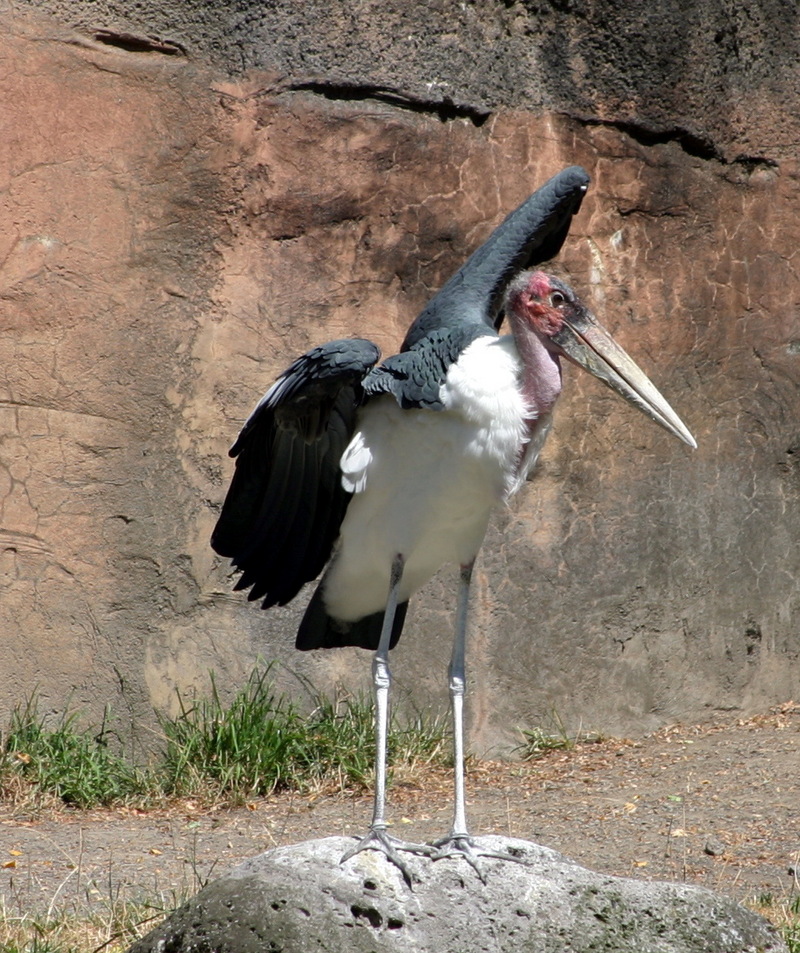|
| 질의: Crocodile bird | 결과: 52번째/79 | |
Marabou Stork (Leptoptilos crumeniferus) - Wiki
| 제목: | Marabou Stork (Leptoptilos crumeniferus) - Wiki
| |

| 해상도: 1035x1233
파일크기: 610231 Bytes
촬영일: 2006:08:06 15:44:39
사진기: Canon EOS 10D (Canon)
F number: f/8.0
Exposure: 1/250 sec
Focal Length: 135/1
등록시간: 2007:09:04 21:36:52
|
ERROR : Server Busy(-1105)
ERROR : Server Busy(-1105)
Marabou Stork (Leptoptilos crumeniferus) - Wiki
Marabou Stork
From Wikipedia, the free encyclopedia
[Photo] Marabou Stork (Leptoptilos crumeniferus) in the Oregon Zoo. Date 8-6-2006. Author http://commons.wikimedia.org/wiki/User:Cacophony
The Marabou Stork, Leptoptilos crumeniferus, is a large wading bird in the stork family Ciconiidae. It breeds in Africa south of the Sahara, occurring in both wet and arid habitats, often near human habitation, especially waste tips.
It is a huge bird. Large specimens are thought to reach a height of 150 cm (60 in), a weight of over 9 kg (20 lbs) and have a wingspan of at least 3.2 m (10.5 ft). In the last regard, it shares the distinction of having the largest wingspan of any landbird with the Andean Condor. Unlike most storks, the three Leptoptilos species fly with the neck retracted like a heron.
The Marabou is unmistakable due to its size, bare head and neck, black back, and white underparts. It has a huge bill, a pink gular sack at its throat, a neck ruff, and black legs and wings. The sexes are alike, but the young bird is browner and has a smaller bill. Full maturity is not reached for up to four years.
Like most storks, the Marabou is gregarious and a colonial breeder. In the African dry season (when food is more readily available as the pools shrink) it builds a tree nest in which two or three eggs are laid.
It also resembles other storks in that it is not very vocal, but indulges in bill-rattling courtship displays. The throat sack is also used to make various noises at that time.
The Marabou Stork is a frequent scavenger, and the naked head and neck are adaptations to this, as it is with the vultures with which the stork often feeds. In both cases, a feathered head would become rapidly clotted with blood and other substances when the bird's head was inside a large corpse, and the bare head is easier to keep clean.
This large and powerful bird will eat different kinds of animals, either alive or as carrion, including small mammals, reptiles, and similar prey. Living prey includes termites, fish, locusts, grasshoppers, caterpillars, frogs, rodents, crocodile eggs and hatchlings, quelea nestlings, doves, young and adult flamingos, cormorant nestlings, and pelican chicks.
http://en.wikipedia.org/wiki/Marabou_Stork
| The text in this page is based on the copyrighted Wikipedia article shown in above URL. It is used under the GNU Free Documentation License. You may redistribute it, verbatim or modified, providing that you comply with the terms of the GFDL. |
|
댓글 |
|---|
| | 손님 |
|
Scientific Name: Leptoptilos crumenifer (Lesson, 1831)
Synonyms: Leptoptilos crumeniferus
Common Names: Marabou, Marabou Stork
French: Marabout d’Afrique German: Marabu Spanish: Marabú africano
Taxonomy: Ciconia crumenifera Lesson, 1831, Senegal. |
^o^
동물그림창고 똑똑전화 누리집
^o^
|
|
|

